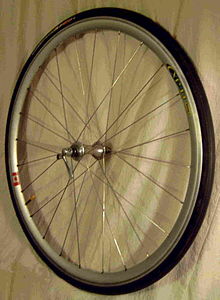輻條
此條目翻譯品質不佳。 |

輻條是從車輪中心的輪轂(即與軸相連的地方)輻射出來的杆、條等,它把輪轂和圓形的輪圈連接起來。
歷史
[編輯]輻條輪的出現使車輛更加輕便。輻條最早出現在公元前2000年的安德羅諾沃文化中。不久之後,高加索地區的游牧民族就使用了裝有輻條輪的馬戰車,持續將近三個世紀。他們隨後開始遷移,深入希臘半島,與當地的地中海民族匯合,在米諾斯文明消亡之後建立了古典希臘(後被斯巴達吞併)。凱爾特人則在公元前幾百年就在戰車車輪外加上了鐵圈。這種輻條輪一直沿用至1870年代,這時鋼絲輪和橡膠輪胎問世了。[1]
類型
[編輯]輻條的材質可以是木頭、金屬、合成纖維等,這取決於輻條是受拉還是受壓。
壓縮輻條
[編輯]木質輻條輪最早用於馬車和馬拉的貨車。早期的機動車用的通常是裝在炮架上的木質輻條輪。
簡易的木質輪輪轂受壓時,輪圈靠近地面的地方會略有凹陷,最低的一根木質輻條因受壓而變短,而其他的輻條則沒有明顯變化。
木質輻條常沿半徑方向安裝,同時呈向外的碟形,以避免車輛搖晃。通過增加碟形的程度還能抵消輻條因受潮而產生的膨脹。[2]
張力輻條
[編輯]自行車的車輪不是笨重的木質輻條輪,而是鋼絲輪。這種車輪更加輕便,它的輻條是拉緊但可調節的金屬絲。輪椅、摩托車、汽車也用這種車輪。
類型
[編輯]有些車輪的輻條可以一根根取下,若有彎曲或折斷便能更換。自行車和輪椅車輪的輻條就是這樣。品質高的自行車所配的常規車輪用的是不鏽鋼輻條,而比較便宜的自行車用的是鍍鋅或鍍鉻的輻條。高品質的輻條可承受225千克力,不過實際使用時負載只有它的幾分之一以避免疲勞損壞。因為自行車和輪椅的輻條只會處於拉伸狀態,其材質也可以是柔韌性強的材料(如合成纖維)。[3]
對負載的反應
[編輯]當編得很好的鋼絲輻條輪承受徑向負載(如車手坐在自行車上)時,車輪與地面接觸處附近會略有凹陷,其餘部分則基本保持圓形。[4][5][6][7] 所有輻條的張力都沒有顯著增加,輪轂正下方的輻條張力還有所降低。[8][9][10][11] 對如何描述這種情形存在爭議。[12] 有人認為輪轂「站」在正下方那根張力減小的輻條上,[6][8] 還有人認為輪轂「掛」在正上方那根張力較大的輻條上。[10][13]
雖然鋼絲輪的輻條又細又柔韌,但沿半徑方向卻是剛性的,所以輻條的懸掛隨動與高壓自行車輪胎相比都不值一提。 [14][15][16][17]
參考文獻
[編輯]- ^ Herlihy, David. Bicycle: the History. Yale University Press. 2004: 141 [2009-09-29]. ISBN 0-300-10418-9. (原始內容存檔於2016-01-06).
- ^ Hansen Wheel and Wagon Shop. 2006 [2006-08-22]. (原始內容存檔於2006-08-14).
- ^ PBO Spoke Technology. 2006 [2011-10-21]. (原始內容存檔於2011-10-30).
- ^ Forester, John. Held Up By Downward Pull. American Wheelmen. August 1980.
- ^ Whitt, Frank R.; David G. Wilson. Bicycling Science Second. Massachusetts Institute of Technology. 1982: 106–138. ISBN 0-262-23111-5.
- ^ 6.0 6.1 Ian Smith. Bicycle Wheel Analysis. [2008-12-31]. (原始內容存檔於2021-04-18).
I conclude that it is perfectly reasonable to say that the hub stands on the lower spokes, and that it does not hang from the upper spokes.
- ^ C.J. Burgoyne and R. Dilmaghanian. Bicycle Wheel as Prestressed Structure (PDF). Journal of Engineering Mechanics. March 1993, 119 (3): 439–455 [2015-08-21]. ISSN 0733-9399. doi:10.1061/(asce)0733-9399(1993)119:3(439). (原始內容 (pdf)存檔於2020-11-12).
Only the spokes in contact with the ground, or near the ground, show significant strains.
- ^ 8.0 8.1 Brandt, Jobst. The Bicycle Wheel. Avocet. 1981: 12–20. ISBN 0-9607236-2-5.
- ^ Wilson, David Gordon; Jim Papadopoulos. Bicycling Science Third. Massachusetts Institute of Technology. 2004: 389–390. ISBN 0-262-73154-1.
- ^ 10.0 10.1 Tom Fine. Hubs hang from the rim!. September 1998 [2010-03-16]. (原始內容存檔於2021-05-06).
I still say, without any doubt, that the hub hangs from the upper spokes.
- ^ Henri P. Gavin. Bicycle Wheel Spoke Patterns and Spoke Fatigue (PDF). ASCE Journal of Engineering Mechanics. August 1996, 122 (8): 736–742 [2015-08-21]. doi:10.1061/(ASCE)0733-9399(1996)122:8(736). (原始內容 (pdf)存檔於2012-09-07).
- ^ Kraig Willett. Hang or Stand?. BikeTech Review. 5 September 2004 [2010-03-16]. (原始內容存檔於2010-03-11).
A little known semantic debate ... has been raging on the usenet newsgroups for quite some time. The point of contention in this debate is whether or not a loaded bicycle wheel "stands" on the bottom spokes or "hangs" from the top ones?
- ^ Samuel K. Clark, V. E. Gough. Mechanics of Pneumatic Tires. U.S. Department of Transportation. 1981: 241.
The system of load transmission is analogous to that of a cycle wheel where the hub hangs by the steel wire spokes from the top of the rim, which is loaded at the bottom.
- ^
John Swanson. Performance of the Bicycle Wheel, A Method for Analysis (PDF). BikePhysics.com. 2006 [2012-06-25]. (原始內容 (PDF)存檔於2012-09-15).
Radial Stiffness: There's almost -no- vertical compliance in your wheel and people who insist that they can feel the vertical stiffness or 「harshness」 of a wheel are mistaken. The radial stiffness of a bicycle wheel is ~ 3-4000 N/mm. This equals a deflection of 0.1 mm under a 40 kg load. Sorry princess, but that gets obscured by the amount of deflection in the tires, fork, saddle, handlebar tape, frame, and even your gloves.
- ^ Henri P. Gavin. Bicycle Wheel Spoke Patterns and Spoke Fatigue (PDF). ASCE Journal of Engineering Mechanics. 1996 [2012-06-25]. (原始內容 (PDF)存檔於2012-09-07).
radial wheel stiffness (N/mm): 2500-5000
- ^ Ian. Spoke Patterns. astounding.org.uk. 2002 [2012-06-25]. (原始內容存檔於2021-04-14).
A radially spoked wheel is about 4.6% stiffer than a tangentially spoked one. Alternatively, if you apply 1000N (about 100kg, 220lb) to each of the wheels, the tangential (four-cross) spoked one deflects 0.0075mm (0.0003 inch) more than the radial spoked. Since the tyre is likely to deflect several millimetres at least (if 3mm, that's 400 times more deflection) I conclude the spoking is unlikely to make a discernible difference to the vertical stiffness of the wheel.
- ^ Jobst Brandt. Sheldon Brown's Bicycle Glossary: Radial spoking. Sheldon Brown (bicycle mechanic). 1981 [2012-06-25]. (原始內容存檔於2007-12-18).
There is no change in radial elasticity between a radial and crossed spoke wheel with the same components, other than the length of the spokes. A 290 mm spoke is 3% stiffer than a 300 mm spoke of the same type. Since spokes stretch elastically about 0.1mm on a hard bump (not ordinary road ripples), the elastic difference between the radial and cross-three wheel is 3% x 0.1mm = 0.003 mm. Copier paper is 0.075 mm thick, and if you can feel that when you ride over it on a glassy smooth concrete surface, please let me know. You have greater sensitivity than the lady in "the princess and the pea" fable.

